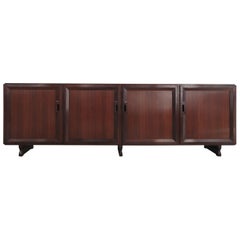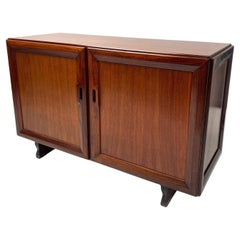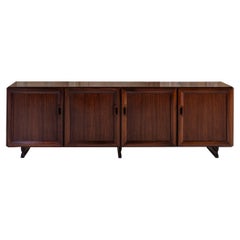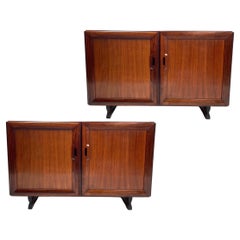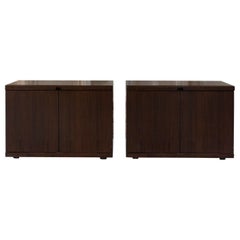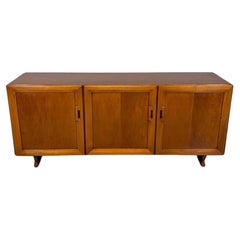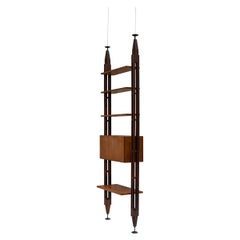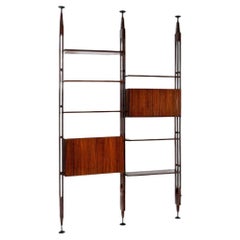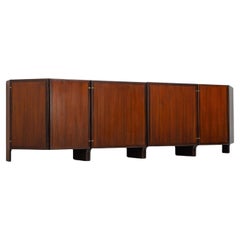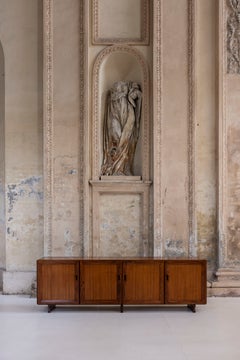Poggi Sideboards
to
3
Height
to
Width
to
Depth
to
5
1
7
7
1
6
5
1
3
1
7
1
1
1
7
7
7
7
7
50
128
66
50
36
Creator: Poggi
Franco Albini Italian Midcentury Dark Wood Sideboard for Poggi, 1950s
By Franco Albini, Poggi
Located in Reggio Emilia, IT
Italian Mid-Century Modern design credenza sideboard designed by Franco Albini and produced by Poggi Pavia from 1958, four doors with sliding shelves and a pull-out shelf / tray, sol...
Category
1850s Italian Mid-Century Modern Antique Poggi Sideboards
Materials
Wood
$11,309 Sale Price
20% Off
Franco Albini, Mid-Century "MB15" sideboard for Poggi, Italy 1957
By Poggi, Franco Albini
Located in Argelato, BO
Franco Albini, MB15 pair of sideboards for Poggi, Italy, 1957
The MB15 sideboard by Franco Albini shown in the images feature a refined and understated design, typical of the Italia...
Category
1950s Italian Mid-Century Modern Vintage Poggi Sideboards
Materials
Wood
$4,656 Sale Price / set
20% Off
Midcentury sideboard designed by Franco Albini for Poggi, Italy 1950
By Franco Albini, Poggi
Located in Piacenza, Italy
Elegant sideboard, model MB 51, designed by Franco Albini for Poggi
Italy, 1950s
Sophisticated and timeless, the MB 51 sideboard is an iconic piece designed by Franco Albini for the ...
Category
1950s Italian Mid-Century Modern Vintage Poggi Sideboards
Materials
Wood
Franco Albini, Pair of Mid-Century "MB15" sideboards for Poggi, Italy 1957
By Poggi, Franco Albini
Located in Argelato, BO
Franco Albini, MB15 pair of sideboards for Poggi, Italy, 1957
The two MB15 sideboards by Franco Albini shown in the images feature a refined and understated design, typical of the I...
Category
1950s Italian Mid-Century Modern Vintage Poggi Sideboards
Materials
Wood
$9,028 Sale Price
24% Off
Midcentury pair of sideboards MB 55 designed by Vico Magistretti for Poggi Pavia
By Vico Magistretti, Poggi
Located in Piacenza, Italy
Pair of wooden sideboards designed by Vico Magistretti for Poggi Pavia.
These Vico Magistretti's sideboards designed for Poggi Pavia are iconic pieces that combine functionality and ...
Category
1970s Italian Mid-Century Modern Vintage Poggi Sideboards
Materials
Wood
Rare of Sideboard "Mb15" by Franco Albini for Poggi
By Franco Albini and Franca Helg, Poggi
Located in Rovereta, Repubblica di San Marino
Rare of walnut sideboard model "Mb15" by Franco Albini for Poggi.
Perfect condition.
Category
Mid-20th Century Italian Mid-Century Modern Poggi Sideboards
Materials
Walnut
Italian Franco Albini for Poggi Sideboard
By Poggi, Franco Albini
Located in Hudson, NY
An Italian model MB 51 sideboard designed by Franco Albini for Poggi. Made of solid teak with a minimalist design and sharp lines.
Category
Mid-20th Century Italian Mid-Century Modern Poggi Sideboards
Materials
Teak
Related Items
Midcentury LB7 modular bookcase designed by Franco Albini for Poggi, Italy 1957
By Franco Albini, Poggi
Located in Piacenza, Italy
Modular bookcase model LB7 designed by Franco Albini for Poggi.
Marked Poggi Pavia.
An extremely flexible bookcase, with different modular options, suited to being against a wall or...
Category
1950s Italian Mid-Century Modern Vintage Poggi Sideboards
Materials
Wood
$10,691
H 118.12 in W 35.44 in D 15.75 in
LB7 Bookshelves, Franco Albini for Poggi, 1960
By Franco Albini
Located in Milano, Lombardia
The LB7 "Infinito" bookcase by Franco Albini for Poggi is an iconic creation of 1950s Italian design. This bookcase, designed in 1957, bears Albini's distinctive signature with its c...
Category
1960s Italian Mid-Century Modern Vintage Poggi Sideboards
Materials
Teak
Italian Sideboard Style of Paolo Buffa, 1950s
By Paolo Buffa
Located in Budapest, HU
A wonderful multifunctional Italian sideboard cabinet bar style of Paolo Buffa, 1950s.
Category
1950s Italian Vintage Poggi Sideboards
Materials
Wood
$2,661 Sale Price
25% Off
H 58.27 in W 89.77 in D 20.08 in
Franco Albini Modular bookcase model "LB7" Production Poggi Pavia 1957
By Franco Albini
Located in Vigevano, PV
Franco Albini
Modular bookcase model "LB7"
Production Poggi Pavia 1957
This bookcase has two storage modules, one divided into 4 sections and the other with a shelf. Plus two shelves...
Category
1950s Italian Mid-Century Modern Vintage Poggi Sideboards
Materials
Aluminum
$8,909
H 118.12 in W 35.44 in D 15.75 in
1950s Italian Art Deco Mid-Century Modern Wood Glass Brass Credenza Sideboard
By Vittorio Dassi, Melchiorre Bega, Guglielmo Ulrich, Paolo Buffa, Ico & Luisa Parisi
Located in Carimate, Como
Beautiful Italian 1950s sideboard, credenza, buffet with very elegant shapes and classic wood worked according its natural light graining. This great piece has 6 frontal drawers and ...
Category
Mid-20th Century Italian Mid-Century Modern Poggi Sideboards
Materials
Brass
$2,851 Sale Price
20% Off
H 30.71 in W 72.05 in D 20.87 in
French Midcentury Extra Large Modernist Oak Sideboard, 1950s
Located in Paris, IDF
This attractive sideboard features a smooth oak build and bright copper accents. Monumental in size. The eye-catching coral and black decorative knobs...
Category
1950s French Mid-Century Modern Vintage Poggi Sideboards
Materials
Copper
Mid-Century Modern Small Wooden Sideboard by Franco Albini, Italy, 1950s
By Franco Albini
Located in Brussels, BE
Mid-Century Modern Small Wooden Sideboard by Franco Albini, Italy, 1950s
Category
1950s Italian Mid-Century Modern Vintage Poggi Sideboards
Materials
Wood
$4,989
H 30.32 in W 53.94 in D 18.71 in
Franco Albini Rosewood Mid-Century Modern “LB7” Modular Bookcase for Poggi, 1957
By Poggi, Franco Albini
Located in Vicenza, IT
LB7 bookcase, designed by Franco Albini and manufactured by Poggi in 1957.
Modular bookstore composed by upholds, containers with flying and doors, shelve. The industrial standard for every product component allows permanent and different solutions, from the bearing structures to the elements. The structure does not need anchorages to the wall and can be placed in the middle of the space.
This set is composed of 3 modules, ten shelves, and three containers.
It is made of Rosewood, iron, and brass.
Excellent vintage condition.
Franco Albini was born in Robbiate in 1905, and after his childhood and part of his youth, he moved to Milan.
He graduated at Politecnico of Milan, Faculty of Architecture, in 1929, and He collaborated for three years in Giò Ponti and Emilio Lancia’s office. He probably had his international contacts here, at The International Exposition of 1929 in Barcelona and Paris, where he visited le Corbusier’s office, as Franca Helg used to tell.
Throughout these first three years, his works were undoubtedly related to XIXth Century. His meeting with Edoardo Persico marks an evident turnover towards rationalism and writers for “Casabella” magazine. Persico’s thoughtful and ironical comments on some of Albini’s drawings for office furniture caused him deep upsetting. “I spent days of real anxiety – tells Albini – I had to answer all questions. I had a long fever”.
The new phase that the meeting provoked begins with opening his own first office at Via Panizza with Renato Camus and Giancarlo Palanti. The group of Architects starts taking care of social housing, participating in the competition for the Baracca neighborhood in 1932, and then realizing the Ifacp neighborhood: Fabio Filzi (1936/38), Gabriele D’Annunzio, and Ettore Ponti (1939).
During those years, He also worked for his first private villa (Pestarini).
It is mainly in the context of exhibitions that the Italian architect experiments the compromise between rigor and poetic fantasy that Pagano was talking about; He conceived all the elements that would become recurrent in all types of his work – Architecture, Interiors, Design. The 1933 opening of the new Triennale of Milano, in Palazzo dell’Arte, becomes an occasion to express the highly innovative character of rationalist thinking. In this place, to experiment with new materials and solutions, but most of all a “method”.
Young rationalist architects cultivated the art of exhibiting as a communication lab, an open field to space solutions.
Albini, with Giancarlo Palanti, sets the steel structure house (with R. Camus, G. Mazzoleni, G. Minoletti and coordination by G. Pagano) designing also its furniture. For the next Triennale in 1936, marked by Persico’s early death, Franco Albini, together with a group of young architects around Pagano, takes care of the exhibition of Dwelling, where he presented 3 types of lodgings.
In the same year, Albini and Romano design the exhibition for Ancient Italian jewelry: vertical uprights, simple linear poles design space. This element is recurring in other works, like the Scipione exhibition (1941), Vanzetti stand (1942), and Olivetti shop in Paris (1956). The architectural space is readable through a grid, introducing a third dimension, the vertical one, with a sense of lightness and transparency.
Upright is also used in design objects, such as the Veliero bookcase...
Category
1950s Italian Mid-Century Modern Vintage Poggi Sideboards
Materials
Brass, Iron
$32,075
H 109.45 in W 104.34 in D 13.78 in
Italian Mid-Century Large Bookcase in Style of Franco Albini
By Franco Albini and Franca Helg
Located in Los Angeles, CA
Italian bookcase metal base . Extra tall,
two cabinets and wooden shelving.
Can be easily disassembled for shipping. USA in Home delivery 2-4- weeks...
Category
1950s Italian Mid-Century Modern Vintage Poggi Sideboards
Materials
Metal
$2,000 Sale Price
50% Off
H 115 in W 66 in D 15 in
Mid-Century Modern Solid Wood and Colored Glass Italian Pair of Sideboards
By L.A. Studio
Located in Madrid, ES
Pair of sideboards with two folding doors made of solid wood structure and coated with colored glass. Details and handles and legs made of brass.
Production can last between 5 and 6...
Category
1950s Italian Mid-Century Modern Vintage Poggi Sideboards
Materials
Brass
$16,037 / set
H 32.68 in W 36.23 in D 14.97 in
Italian Franco Albini for Poggi Sideboard
By Poggi, Franco Albini
Located in Hudson, NY
An Italian model MB 51 sideboard designed by Franco Albini for Poggi. Made of solid teak with a minimalist design and sharp lines.
Category
Mid-20th Century Italian Mid-Century Modern Poggi Sideboards
Materials
Teak
Lb7 bookcase, designed by Franco Albini for Poggi Pavia, Italy
By Franco Albini, Poggi
Located in Piacenza, Italy
Modular bookshelf designed by Franco Albini in 1956 for Poggi Pavia.
An exceptionally flexible bookshelf with various modular options, suitable to be placed against a wall or used as...
Category
1950s Italian Mid-Century Modern Vintage Poggi Sideboards
Materials
Wood
$32,075
H 111.82 in W 102.37 in D 13.78 in
Previously Available Items
Franco Albini MB48 sideboard Poggi Italy 1963
By Poggi, Franco Albini
Located in Roosendaal, Noord Brabant
Introducing the exceptional Franco Albini MB48 large sideboard, a timeless masterpiece designed in 1963 for Poggi Italy. Part of an iconic modular series by the renowned designer Fra...
Category
1960s Italian Mid-Century Modern Vintage Poggi Sideboards
Materials
Hardwood
Midcentury sideboard designed by Franco Albini for Poggi, Italy 1950
By Poggi, Franco Albini
Located in Piacenza, Italy
Elegant sideboard model MB 51 designed by Franco Albini for Poggi.
Made of wood, the storage has an elegant design and clean lines with four compartments with internal shelves.
Ita...
Category
1950s Italian Mid-Century Modern Vintage Poggi Sideboards
Materials
Wood
H 30.32 in W 95.67 in D 18.51 in
Mid-Century Sideboard MB15 by Franco Albini for Poggi, Italy, 1957
By Poggi, Franco Albini
Located in Brussels, BE
Mid-Century Sideboard MB15 by Franco Albini for Poggi, Italy, 1957
Category
1950s Mid-Century Modern Vintage Poggi Sideboards
Materials
Wood
Midcentury sideboard designed by Franco Albini for Poggi, Italy 1950
By Poggi, Franco Albini
Located in Piacenza, Italy
Elegant sideboard model MB 51 designed by Franco Albini for Poggi.
Made of wood, the storage has an elegant design and clean lines with four compartments with internal shelves.
Ita...
Category
1950s Italian Mid-Century Modern Vintage Poggi Sideboards
Materials
Wood
H 30.32 in W 95.67 in D 18.51 in
Italian Midcentury Sideboard by Franco Albini E Franca Helg
By Poggi, Franco Albini
Located in Piacenza, Italy
Sideboard model MB48.
Designed by Franco Albini and Franca Helg for Poggi Pavia in 1958, Italy.
Published.
Category
1950s Italian Mid-Century Modern Vintage Poggi Sideboards
Materials
Wood
Franco Albini Italian Midcentury Dark Wood Sideboard Model MB15 for Poggi, 1950s
By Poggi, Franco Albini
Located in Reggio Emilia, IT
Italian rare and famous dark wood midcentury modern design sideboard model MB15 designed by Franco Albini for POGGI Pavia in 1958,
model with two doors, sliding shelve and a pull-ou...
Category
1850s Italian Mid-Century Modern Antique Poggi Sideboards
Materials
Wood
H 30.52 in W 48.04 in D 18.51 in
Vico Magistretti Samarcanda Sideboard in Black Wood and Skai by Poggi 1970s
By Vico Magistretti, Poggi
Located in Cascina, Pisa
Samarcanda or CS49 sideboard composed of two modules in black lacquered beech plywood and top in wood covered with black skai.
This Samarcanda sideboards presents frontal drawers and doors revealing inner shelves.
Designed by Vico Magistretti and produced by Poggi in 1970s
Samarcanda is an easily stackable system of drawers and containers that can compose living-room furniture, chests of drawers, tables and desks. It is a system of self-standing drawers made of beech multi-layered plywood lacquered with polyurethane paint in black and white that can be freely stacked and combined.
Licterature:
R. Dulio, F. Marino, S.A. Poli, Il mondo di Poggi. L'officina del design e delle arti, Electa, Milano 2019, p. 129
Domus 1971, 497
Ludovico Magistretti was born in Milan on 6 October 1920. He went to Parini High School and in autumn 1939 enrolled in the Faculty of Architecture at the Royal Polytechnic in Milan.
After 8 September 1943, to avoid being deported to Germany, he left Italy during his military service and moved to Switzerland, where he took some academic courses at the Champ Universitaire Italien in Lausanne, taught at the local university.
During his stay in the Swiss city he met Ernesto Nathan Rogers, the founder of the BBPR firm who had taken refuge in Switzerland after racist laws were passed in Italy. This was a key encounter in Magistretti’s intellectual and professional development, since the architect from Trieste turned out to be his maestro.
He returned to Milan in 1945, where he graduated in Architecture at the Polytechnic on 2 August. He then immediately began his career working with the architect Paolo Chessa at the firm owned and run by his father, who died prematurely that same year.
Here, in his father’s small firm, he spent his entire career in partnership with Franco Montella.
During reconstruction operations in Milan from 1949-59, Magistretti designed and constructed about 14 projects for INA-Casa in conjunction with other architects.
He was involved with Mario Tedeschi in the joint project for the QT8 neighbourhood, designing houses for veterans from the African campaign and also Santa Maria Nascente Church.
In 1946 he participated in the R.I.M.A. exhibition (Italian Assembly for Furniture Exhibitions), held at the Palazzo dell’Arte, designing some small almost self-made pieces of furniture and then, in 1947 and 1948, he took part together with Castiglioni, Zanuso, Gardella, Albini and others in the exhibitions organized by Fede Cheti, a furniture fabric maker, held at her own workshop.
The young architect was involved in plenty of activities and came up with lots of new ideas and proposals in the 1950s.
Over the following years he also designed a number of other important projects, including the Towers in piazzale Aquileia (1961-64), Bassetti House in Azzate (1960-62), Cassina House in Carimate (1964-65), and the house in via Conservatorio in Milan (1963-66).
In 1956 he was one of the founding members of the ADI, Industrial Design Association, and during the same year he was a member of the panel of judges for the Golden Compass Award for the first time.
His work as an architect was almost totally focused on the issue of housing and living from the 1960s onwards, as he developed his own extremely expressive idiom, which, even though it was heavily criticised at times, made a real impression on the architectural scene in Lombardy during that period, making him one of its leading figures.
This is the context in which he took part in the CIAM Congress (International Modern Architecture Congress) held in Otterlo in the Netherlands in 1959, during which the Italians presented Velasca Tower designed by the BBPR, the Olivetti canteen designed by Ignazio Gardella, Arosio house designed by Vico Magistretti (1956-59), and the houses in Matera designed by Giancarlo De Carli...
Category
1970s Italian Post-Modern Vintage Poggi Sideboards
Materials
Faux Leather, Wood
H 29.14 in W 86.62 in D 21.26 in
Franco Albini Italian Midcentury Dark Wood Sideboard Model MB15 for Poggi, 1950s
By Poggi, Franco Albini
Located in Reggio Emilia, IT
Italian rare and famous dark wood midcentury sideboard model MB 15 designed by Franco Albini for POGGI in 1958, 3 doors with sliding shelves and a pull-out shelf/tray.
Wood veneer, ...
Category
1850s Italian Mid-Century Modern Antique Poggi Sideboards
Materials
Wood
H 30.32 in W 72.05 in D 18.51 in
Franco Albini Sideboard in Teak
By Poggi, Franco Albini
Located in Waalwijk, NL
Franco Albini for Poggi, sideboard MB 51, teak, Italy, 1950
Well-designed long sideboard by Franco Albini for Poggi, which features a simplistic design with sharp lines. This modern...
Category
1950s Italian Mid-Century Modern Vintage Poggi Sideboards
Materials
Teak
Large Franco Albini Sideboard in Teak
By Poggi, Franco Albini
Located in Waalwijk, NL
Franco Albini for Poggi, sideboard MB 51, teak, Italy, 1950
Well-designed long sideboard by Franco Albini for Poggi, which features a simplistic design with sharp lines. This mode...
Category
1950s Italian Mid-Century Modern Vintage Poggi Sideboards
Materials
Teak
Franco Albini for Poggi Midcentury Wood Italian Sideboard, 1950s
By Poggi, Franco Albini
Located in Reggio Emilia, IT
Wood Italian sideboard designed by Italian artist Franco Albini and produced by Poggi Pavia,
two-door model with wood veneer, feet, door frames and details in solid wood, 1950s
B...
Category
1850s Italian Mid-Century Modern Antique Poggi Sideboards
Materials
Wood
Franco Albini Italian Midcentury Wood Sideboards Model MB15 for Poggi, 1950s
By Poggi, Franco Albini
Located in Reggio Emilia, IT
Italian couple of wood sideboards model MB15 designed by Franco Albini and produced by Poggi Pavia,
two-door models with wood veneer, feet, door frame...
Category
1850s Italian Mid-Century Modern Antique Poggi Sideboards
Materials
Wood
H 30.32 in W 47.64 in D 18.51 in
Poggi sideboards for sale on 1stDibs.
Poggi sideboards are available for sale on 1stDibs. These distinctive items are frequently made of wood and are designed with extraordinary care. There are many options to choose from in our collection of Poggi sideboards, although brown editions of this piece are particularly popular. Many of the original sideboards by Poggi were created in the mid-century modern style in italy during the mid-20th century. If you’re looking for additional options, many customers also consider sideboards by Pace Collection, Luciano Frigerio, and Sormani. Prices for Poggi sideboards can differ depending upon size, time period and other attributes — on 1stDibs, these items begin at $5,500 and can go as high as $12,800, while a piece like these, on average, fetch $10,293.
